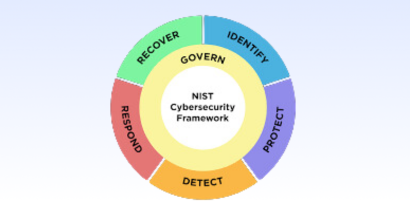Good CISOs know that Cyber GRC stands as the cornerstone for business resilience. Great CISOs understand that Cyber GRC isn’t just a foundation but a dynamic framework that propels business resilience forward. They recognize that effective Cyber Governance, Risk, and Compliance (GRC) isn’t a static concept but an ongoing journey of adaptation and innovation. Great CISOs leverage Cyber GRC as a strategic advantage, seamlessly integrating it into the organization’s DNA to anticipate and mitigate emerging threats while fostering a culture of continuous improvement and resilience. And that’s why good governance matters now, more than ever before. The National Institute of Standards and Technology (NIST) agrees. Introducing NIST CSF 2.0, the latest iteration of the National Institute of Standards and Technology Cybersecurity Framework, unveiling the pioneering “Govern” function.

NIST CSF 2.0 Govern: A Holistic Approach to Cybersecurity Management
NIST CSF 2.0 revolutionizes cybersecurity management by introducing the “Govern” function, placing a significant emphasis on top-down strategic planning and coordination. This function serves as the cohesive element that integrates various cybersecurity functions into a unified strategy, ensuring alignment across governance, risk management, and compliance efforts.
Strengthening Risk Management with Continuous Control Monitoring (CCM)
One of the key features of NIST CSF 2.0 is the advocacy for enhancements through Continuous Control Monitoring (CCM) and automation. By emphasizing the constant evaluation of compliance with selected cybersecurity requirements, organizations can dynamically assess their cybersecurity posture through automated means. This proactive approach enables organizations to identify and mitigate potential vulnerabilities and threats promptly, strengthening their risk management capabilities and ensuring ongoing compliance and resilience against evolving cyber threats.
Empowering Leadership and Driving Strategic Opportunities
The introduction of the Govern function also empowers organizational leaders by emphasizing the definition and implementation of leadership responsibilities within cybersecurity management. This empowerment fosters a culture of accountability and resilience, allowing leaders to proactively drive cybersecurity initiatives.
Moreover, Govern facilitates the identification of positive risks, enabling organizations to capitalize on strategic opportunities. By recognizing and leveraging these opportunities, organizations can enhance their cybersecurity posture while aligning with broader strategic objectives.
Integration: Govern as the Glue
Govern serves as the integrative glue, unifying disparate cybersecurity functions into a coherent strategy. It ensures that efforts across identification, protection, detection, response, and recovery are aligned, reinforcing overall cyber resilience. With the inclusion of Govern, NIST CSF 2.0 strengthens organizations’ security and risk management capabilities, providing a comprehensive framework to address cybersecurity challenges across the entire threat landscape.
NIST CSF 2.0: A Milestone for Governance
In conclusion, NIST CSF 2.0’s Govern function represents a significant milestone in cybersecurity management. By emphasizing a holistic approach and empowering organizations with enhanced risk management capabilities, it equips them to navigate the complex cybersecurity landscape effectively. As organizations continue to evolve in the digital age, embracing the principles of NIST CSF 2.0 Govern is crucial for building a resilient cybersecurity posture and mitigating cyber risks effectively.
